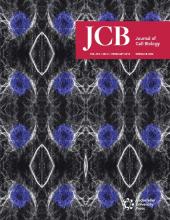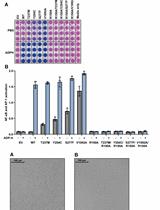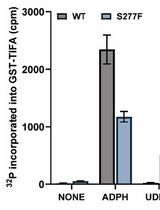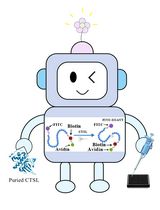- EN - English
- CN - 中文
Subcellular Fractionation of Hela Cells for Lysosome Enrichment Using a Continuous Percoll-density Gradient
利用连续percoll密度梯度富集hela细胞溶酶体亚细胞组分
发布: 2019年09月20日第9卷第18期 DOI: 10.21769/BioProtoc.3362 浏览次数: 9514
评审: Ralph Thomas BoettcherManish ChamoliAnonymous reviewer(s)
Abstract
The enrichment of lysosomes is a useful way to study their structure and function. These dynamic vesicles can be enriched from cell cultures in a variety of ways including immunoprecipitation and fluorescence-activated organelle sorting. These methods are extremely precise but often require the transfection and expression of an affinity or fluorophore-tagged lysosomal membrane protein. A simpler approach uses differential density of subcellular organelles, which are characteristic to a particular type of organelle. Separation of organelles along a density-gradient enables fractionation to enrich for specific organelles (such as lysosomes) in their native state. This protocol outlines an optimized method for enriching lysosomes from HeLa cells with a continuous density-gradient that contains Percoll. Gentle cell lysis and extraction conditions yield dense-fractions that are enriched with functional and intact lysosomes, which can be assayed in downstream analyses. This method is quick (conducted in less than 2 h after harvesting cells), and can be easily scaled and optimized for other cell types.
Keywords: Lysosome (溶酶体)Background
The lysosomal system is the cell’s recycling center and is responsible for breaking down macromolecules such as proteins, carbohydrates and lipids. This system is responsible for quality control and is one of the cell’s front-line defenses against aging. As such, researching lysosomal function has found application in age-related diseases such as Alzheimer’s and Parkinson’s disease, which are both genetically associated with the lysosomal system (Gao et al., 2018), and display profound lysosomal system dysfunction (Whyte et al., 2017). The enrichment or purification of cellular organelles that are a part of the lysosomal system is a powerful way to study their structure and function.
Enrichment of subcellular structures such as lysosomes and related organelles from cell cultures can be conducted in a variety of ways including immunoprecipitation, fluorescence-activated organelle sorting, and magnetic separation of organelles that contain superparamagnetic iron nanoparticles (Gauthier et al., 2008; Abu-Remaileh et al., 2017; Lloyd-Lewis et al., 2018). Whilst being extremely precise these methods often require the transfection and expression of an affinity or fluorophore-tagged lysosomal membrane protein (e.g., LAMP1, LAMP2 or TMEM192). Density-gradients offer an alternative simple approach that takes advantage of the different densities of specific organelles.
The use of Percoll for the creation of density gradients with which cells can be fractionated and organelles enriched is an easy-to-use and well-established method (Pertoft et al., 1978). Separation of cell lysates along a density-gradient enables fractionation to enrich for specific organelles (such as lysosomes) in their native state. Percoll media itself is made of polydisperse silica particles that are coated in polyvinylpyrrolidone that have an average size in water of 35 nm. One of the main advantages of using Percoll above other media is that it has a low osmolality. Osmolality does not change with respect to position in a Percoll gradient. This contrasts with sucrose gradients, and even Ficoll (sucrose polymer) gradients that change in osmolality with respect to position in the density gradient (Pertoft, 2000).
This protocol outlines an optimized method for enriching lysosomes from HeLa cells with a density-gradient that contains Percoll (summarized in Figure 1A). Gentle extraction conditions yield dense-fractions that are enriched with functional and intact lysosomes. These fractions can be measured for lysosomal proteins and lysosomal enzyme activity (Cui et al., 2019). This method is quick (i.e., can be performed in < 2 h after harvesting cells), and can be easily scaled for size and optimized for other cell types.
Materials and Reagents
- 1.5 ml tube (Sigma, catalog number: T9661-500EA)
- 10 ml syringe (Terumo, catalog number: 55+10S)
- 10 ml tube (SARSTEDT, catalog number: 62-9924-284)
- 20 ml syringe (BD Plastipak, catalog number: 300613)
- 21 G x 1½” needle (Terumo, catalog number: NN*2138R)
- 23 cm cell scraper, radiation sterilized (Nunc, catalog number: 179693)
- 75 cm2 canted neck non-pyrogenic polystyrene (T75) flasks (Sigma, catalog number: CLS430641U-100EA)
- P200, P1000 pipette tips
- Parafilm (Bemis, catalog number: PM-996)
- HeLa cells (ATCC, catalog number: CRM-CCL-2)
- Thickwall open-top 31 ml ultracentrifuge tubes (Beckman Coulter, catalog number: 355631)
- cOmplete tablets, EDTA-free easy pack (protease inhibitors) (Roche, catalog number: 04693132001)
- Dulbecco’s Modified Eagle Medium, high glucose and L-glutamine (DMEM) (Gibco, catalog number: 11965-092)
- Dulbecco’s phosphate buffered saline (DPBS) (Gibco, catalog number: 14190-136)
- Ethylenediaminetetraacetic acid disodium salt dihydrate (EDTA) (Sigma Aldrich, catalog number: E5134)
- Foetal Bovine Serum (FBS) (Gibco, catalog number: 10099-141)
- HEPES (Sigma, catalog number: H3375-100G)
- Mixing cannula (catheter) (Fairmont Medical, catalog number: MIX1001)
- Percoll (GE Healthcare, catalog number: 17-0891-02)
- Sucrose (Sigma, catalog number: S0389-1KG)
- Trypsin-EDTA solution 1x (Sigma, catalog number: 59430C-100ML)
- (Optional) Pefabloc (Merck, catalog number: 11429868001), or Pepstatin A (Sigma-Aldrich, catalog number: 77170)
- Sucrose buffer (see Recipes)
- Sucrose buffer supplemented with protease inhibitors (see Recipes)
- 18% (v/v) Percoll/sucrose buffer (see Recipes)
Equipment
- Pipettes (P200, P1000)
- -80 °C freezer
- Cell culture incubator (Thermo Scientific, model: Heraeus HERAcell 150i)
- Centrifuge (Thermo Scientific, model: Heraeus Megafuge 40R)
- Laboratory-grade weighing scale
- Retort clamp
- Retort stand
- Fixed angle rotor (Beckman Coulter, model: Type 70Ti)
- Ultracentrifuge (Beckman Coulter, model: Optima XPN-100)
Procedure
文章信息
版权信息
© 2019 The Authors; exclusive licensee Bio-protocol LLC.
如何引用
Readers should cite both the Bio-protocol article and the original research article where this protocol was used:
- Carosi, J. M., Hattersly, K. J., Cui, Y., Yang, Z., Teasdale, R. D. and Sargeant, T. J. (2019). Subcellular Fractionation of Hela Cells for Lysosome Enrichment Using a Continuous Percoll-density Gradient. Bio-protocol 9(18): e3362. DOI: 10.21769/BioProtoc.3362.
- Cui, Y., Carosi, J. M., Yang, Z., Ariotti, N., Kerr, M. C., Parton, R. G., Sargeant, T. J. and Teasdale, R. D. (2019). Retromer has a selective function in cargo sorting via endosome transport carriers. J Cell Biol 218(2): 615-631.
分类
生物化学 > 蛋白质 > 活性
细胞生物学 > 细胞器分离 > 溶酶体
您对这篇实验方法有问题吗?
在此处发布您的问题,我们将邀请本文作者来回答。同时,我们会将您的问题发布到Bio-protocol Exchange,以便寻求社区成员的帮助。
提问指南
+ 问题描述
写下详细的问题描述,包括所有有助于他人回答您问题的信息(例如实验过程、条件和相关图像等)。
Share
Bluesky
X
Copy link












